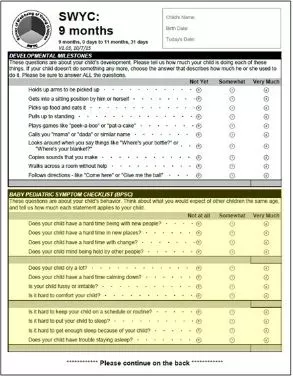BPSC validation information
The BPSC is an emotional/behavioral screening instrument for children under 18 months of age. The BPSC was created as part of a comprehensive screening instrument designed for pediatric primary care and is modeled after the Pediatric Symptom Checklist. BPSC items were developed by a team of experts who reviewed existing assessment instruments and relevant research literature. Scale construction and initial validation were conducted with 205 families from pediatric primary care sites and 54 families from referral clinics. A replication sample of 146 additional families was enrolled from an independent set of primary care practices.
Exploratory factor analysis revealed 3 dimensions of the BPSC: Irritability, Inflexibility and Difficulty with Routines. Factor structure was confirmed in the replication sample. Retest reliability and internal reliability were adequate (ICC > .70) across subscales, with the exception of the Irritability subscale's internal reliability in the replication sample. Construct validity of the Irritability and the Difficulty with Routines subscales is supported by correlations with the Parenting Stress Index and the Ages & Stages Questionnaire: Emotional/Behavioral, but the Inflexibility subscale appears to be distinct from performance on these instruments. Tests of differential item functioning revealed no significant effects for race/ethnicity, child gender, parent education, or family income. Age-based normative data were calculated for each scale.
The BPSC assesses three domains of behavior for very young children and shows promise as a social/emotional screening instrument for pediatric primary care.
BPSC at a glance

Domain:
- Developmental
Age range:
- 1 months, 0 days to 17 months, 31 days
- The BPSC is on the bottom of the front side of the 2-18 month Age-Specific SWYC Forms
Scoring:
- The BPSC is divided into 3 subscales, each with 4 items. Add up each subscale score. Any summed score of 3 or more on any of the 3 subscales indicates that a child is at risk and needs further evaluation or investigation.
- In the event that parents have selected multiple responses for a single question and are unavailable for further questioning, then choose the more concerning answer (i.e. "Somewhat" or "Very Much") farthest to the right.
- In the event that there is a missing response, that item counts as zero.